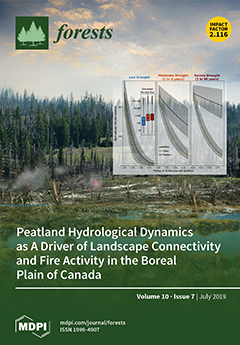The objective of this study was to specify, parameterize, and evaluate an acoustic-based inferential framework for estimating commercially-relevant wood attributes within standing jack pine (
Pinus banksiana Lamb) trees. The analytical framework consisted of a suite of models for predicting the dynamic modulus of elasticity (
me), microfibril angle (
ma), oven-dried wood density (
wd), tracheid wall thickness (
wt), radial and tangential tracheid diameters (
dr and
dt, respectively), fibre coarseness (
co), and specific surface area (
sa), from dilatational stress wave velocity (
vd). Data acquisition consisted of (1) in-forest collection of acoustic velocity measurements on 61 sample trees situated within 10 variable-sized plots that were established in four mature jack pine stands situated in boreal Canada followed by the removal of breast-height cross-sectional disk samples, and (2) given (1), in-laboratory extraction of radial-based transverse xylem samples from the 61 disks and subsequent attribute determination via Silviscan-3. Statistically, attribute-specific acoustic prediction models were specified, parameterized, and, subsequently, evaluated on their goodness-of-fit, lack-of-fit, and predictive ability. The results indicated that significant (
p ≤ 0.05) and unbiased relationships could be established for all attributes but
dt. The models explained 71%, 66%, 61%, 42%, 30%, 19%, and 13% of the variation in
me,
wt,
sa,
co,
wd,
ma, and
dr, respectively. Simulated model performance when deploying an acoustic-based wood density estimate indicated that the expected magnitude of the error arising from predicting
dt,
co,
sa,
wt,
me, and
ma prediction would be in the order of ±8%, ±12%, ±12%, ±13%, ±20%, and ±39% of their true values, respectively. Assessment of the utility of predicting the prerequisite
wd estimate using micro-drill resistance measures revealed that the amplitude-based
wd estimate was inconsequentially more precise than that obtained from
vd (≈ <2%). A discourse regarding the potential utility and limitations of the acoustic-based computational suite for forecasting jack pine end-product potential was also articulated.
Full article





